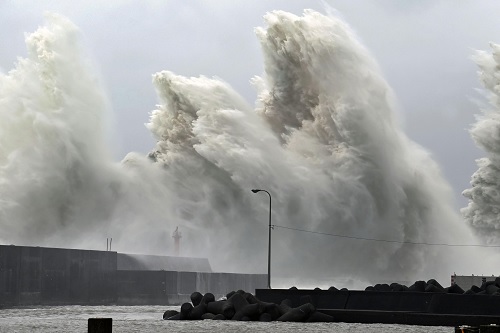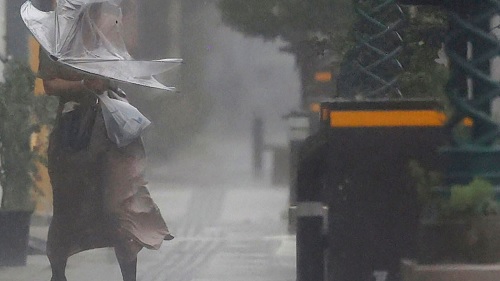Typhoon Nanmadol Forecast are powerful tropical cyclones that can cause extensive damage and loss of life. Typhoon Nanmadol, currently heading toward Japan, is making headlines due to its anticipated landfall with wind gusts of 168 mph to 270 kph. In this article, we will explore the formation, intensity, tracking, impact, and safety measures surrounding Typhoon Nanmadol.

Understanding Typhoon Nanmadol
Typhoon Nanmadol, also known as Typhoon “Nanmadol,” is a large, well-organized storm that originated in the Western Pacific Ocean. It has been classified as a super typhoon due to its intense winds and a strong low-pressure system. The typhoon’s name “Nanmadol” is derived from a term in Korean mythology meaning “a dragon of the south.”
Typhoon Formation and Intensity
Typhoons form over warm ocean waters, where the sea surface temperature is typically above 26.5°C (80°F). The warm waters evaporate and provide energy to the storm, causing it to intensify. As the warm, moist air rises, it cools and condenses, creating thunderstorms and a central eye surrounded by an eyewall. Typhoon Nanmadol has shown rapid intensification, gaining strength quickly and becoming a potent force.
Typhoon Nanmadol Forecast
Tracking typhoons is crucial for disaster preparedness and early warning systems. Meteorological agencies use advanced technologies like satellites, radars, and computer models to monitor the typhoon’s path and predict its trajectory. These predictions enable authorities to issue evacuation orders and mobilize resources in the affected areas.
Landfall in Japan: Preparations and Impact
Japan is no stranger to typhoons, but each storm presents unique challenges. As Typhoon Nanmadol approaches, Japanese authorities are taking necessary precautions to ensure the safety of their citizens. Coastal areas are at high risk of storm surges, flooding, and strong winds. Residents are advised to secure their properties and evacuate to safer locations.
Wind Gusts of 168 mph to 270 kph: Dangers and Safety Measures
Wind gusts of 168 mph (270 kph) pose significant dangers to infrastructure, trees, and even well-constructed buildings. Flying debris and falling trees are common hazards during such extreme winds. It is essential for people to stay indoors during the storm and away from windows to avoid potential injuries.

Aftermath and Recovery Efforts
After Typhoon Nanmadol passes, the affected areas will need immediate assistance and support. Recovery efforts will include restoring power and essential services, clearing debris, and providing aid to those displaced or injured. The resilience and unity of the affected communities play a vital role in rebuilding efforts.
Comparing Typhoon Nanmadol to Past Storms
To better understand the magnitude of Typhoon Nanmadol, it is essential to compare it with previous typhoons that struck Japan or neighboring regions. By analyzing historical data, meteorologists can identify trends and patterns in typhoon behavior, aiding in the preparation and response to future storms.
Climate Change and Typhoon Frequency
The impact of climate change on typhoon frequency and intensity is a subject of ongoing research. While there is no direct link between individual typhoons and climate change, rising sea levels and increasing sea surface temperatures can potentially influence typhoon characteristics. Understanding these connections is critical for devising long-term strategies to mitigate the effects of such storms.
Conclusion
Typhoon Nanmadol’s imminent landfall in Japan with wind gusts of 168 mph (270 kph) is a concerning event that demands attention and preparedness. As we face the challenges posed by natural disasters, it is crucial to prioritize safety, follow evacuation orders, and support affected communities during their recovery process.
FAQs
Q: What is a typhoon?
A: A typhoon is a powerful tropical cyclone that originates over warm ocean waters.
Q: How are typhoons tracked?
A: Meteorological agencies use satellites, radars, and computer models to monitor and predict the trajectory of typhoons.
Q: What are the dangers of high wind gusts during a typhoon?
A: High wind gusts can cause damage to buildings, and infrastructure, and pose risks to human safety.
Q: How does Japan prepare for typhoons?
A: Japanese authorities issue evacuation orders and mobilize resources to protect citizens and properties.
Q: Is there a connection between climate change and typhoon frequency?
A: Climate change may influence typhoon characteristics, but the direct link is still a subject of research.
Visit: The Plant Dads: Your Online Destination for Greenhouse-Delivered Plants


